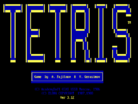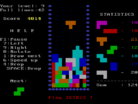Tetris (IBM PC): Difference between revisions
No edit summary |
*>Jujubo easter egg(?) and scoring system. more to come when i have the time. |
||
| Line 14: | Line 14: | ||
'''''Tetris''''' followed its original version for [[Electronica 60]] when [[Vadim Gerasimov]], then sixteen years old, ported it to IBM PC. This version spread through Moscow quickly after he and [[Alexey Pajitnov]] shared it with their friends. | '''''Tetris''''' followed its original version for [[Electronica 60]] when [[Vadim Gerasimov]], then sixteen years old, ported it to IBM PC. This version spread through Moscow quickly after he and [[Alexey Pajitnov]] shared it with their friends. | ||
Download version 3.12 of the first PC version of Tetris from [http://vadim.oversigma.com/Tetris.htm Gerasimov's web page] [http://vadim.oversigma.com/Tetris3.zip here (Tetris3.zip)], and a utility to change the tetromino colors [http://www.tetrisconcept.com/forum/viewtopic.php?t=797 here]. | Download version 3.12 of the first PC version of Tetris from [http://vadim.oversigma.com/Tetris.htm Gerasimov's web page] [http://vadim.oversigma.com/Tetris3.zip here (Tetris3.zip)], and a utility to change the tetromino colors [http://www.tetrisconcept.com/forum/viewtopic.php?t=797 here]. Gerasimov mentions at his site that there's an easter egg hidden in the game, but it's unknown if anyone has discovered it. | ||
==Scoring== | |||
Points are calculated and given only after a piece locks down. No points are given after a piece causes a "game over". | |||
===Drop scoring=== | |||
19 minus the number of active rows fallen. Specifically this measures the distance fallen by the 1x1 block in row 20 column 6 in a newly spawned piece, to the position of that 1x1 block when it ceases to fall at native gravity, and subtracts the number of rows fallen from 19. | |||
For example, at the start of a game a T piece which is allowed to fall to the bottom without player control will give 1 drop point (19 - (row 20 - row 2)), but if the piece were rotated twice the player would earn 0 drop points (19 - (row 20 - row1)) because of the change in the relative position of the 1x1 block mentioned earlier. J and L work the same way. For the pieces with 2 rotational states (I, S, Z) the position of the 1x1 block never changes during rotation, and it is believed that rotating the O does nothing (which is true for drop scoring). | |||
Hard dropping causes a piece to become inactive at the point of execution, therefore hard dropped rows are not deducted. If a piece were hard dropped from row 15 to any point below, the drop points rewarded would be 19 - (20 - 15). There is no additional bonus for hard dropping. | |||
===Level bonus=== | |||
3 points * level given for each piece. | |||
===Draw next off=== | |||
5 points per piece. This option can be turned on and off during a game, but it must remain disabled from before a piece spawns until lockdown in order to earn the bonus for that piece. | |||
===Line scoring=== | |||
There are no points given for clearing lines, even for making tetrises. However it's a viable strategy to stack high to earn more drop points if you feel uncomfortable with hard dropping. | |||
===Phantom bonus=== | |||
None is known. | |||
==See also== | ==See also== | ||
*[[Game]]s | *[[Game]]s | ||
[[Category:Games List]] | [[Category:Games List]] | ||
Revision as of 02:45, 18 May 2009
| Tetris | |
|---|---|
| Developer(s) | Alexey Pajitnov and Vadim Gerasimov |
| Publisher(s) | AcademySoft CCAS USSR Moscow |
| Platform(s) | IBM PC (DOS) |
| Release | 1986, 1988 |
| Gameplay info | |
| Next pieces | One |
| Playfield size | 10x20 |
| Hold piece | No |
| Hard drop | Yes |
| Rotation system | Original Rotation System? |
Tetris followed its original version for Electronica 60 when Vadim Gerasimov, then sixteen years old, ported it to IBM PC. This version spread through Moscow quickly after he and Alexey Pajitnov shared it with their friends.
Download version 3.12 of the first PC version of Tetris from Gerasimov's web page here (Tetris3.zip), and a utility to change the tetromino colors here. Gerasimov mentions at his site that there's an easter egg hidden in the game, but it's unknown if anyone has discovered it.
Scoring
Points are calculated and given only after a piece locks down. No points are given after a piece causes a "game over".
Drop scoring
19 minus the number of active rows fallen. Specifically this measures the distance fallen by the 1x1 block in row 20 column 6 in a newly spawned piece, to the position of that 1x1 block when it ceases to fall at native gravity, and subtracts the number of rows fallen from 19.
For example, at the start of a game a T piece which is allowed to fall to the bottom without player control will give 1 drop point (19 - (row 20 - row 2)), but if the piece were rotated twice the player would earn 0 drop points (19 - (row 20 - row1)) because of the change in the relative position of the 1x1 block mentioned earlier. J and L work the same way. For the pieces with 2 rotational states (I, S, Z) the position of the 1x1 block never changes during rotation, and it is believed that rotating the O does nothing (which is true for drop scoring).
Hard dropping causes a piece to become inactive at the point of execution, therefore hard dropped rows are not deducted. If a piece were hard dropped from row 15 to any point below, the drop points rewarded would be 19 - (20 - 15). There is no additional bonus for hard dropping.
Level bonus
3 points * level given for each piece.
Draw next off
5 points per piece. This option can be turned on and off during a game, but it must remain disabled from before a piece spawns until lockdown in order to earn the bonus for that piece.
Line scoring
There are no points given for clearing lines, even for making tetrises. However it's a viable strategy to stack high to earn more drop points if you feel uncomfortable with hard dropping.
Phantom bonus
None is known.

